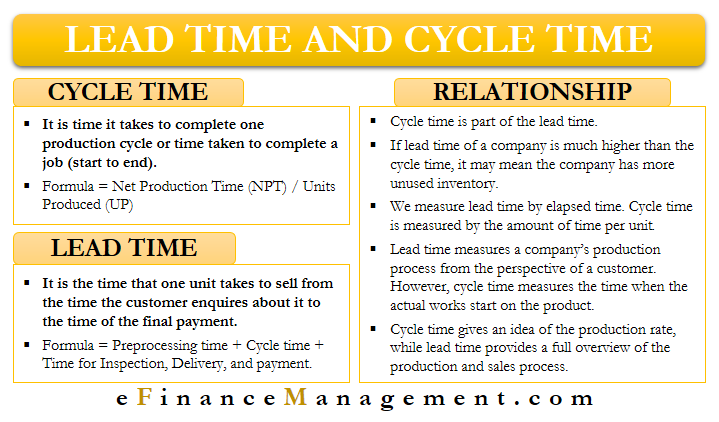Lead Time and Cycle Time are important time measurement metrics that help management to gauge the efficiency of its operations. Moreover, it also helps the management in understanding the improvements it needs to make the processes better. Both Lead Time and Cycle Time are different concepts, but people often use them interchangeably. Such confusion may misguide management in understanding the issues and, eventually, make a wrong decision. Thus, everyone needs to understand the difference and relationship between these two.
Cycle Time
It is the time it takes to complete one production cycle. Or the time it takes to complete a job, from start to the end. For example, for a software company, the cycle time is the time when it starts coding to the release of the software.
For a production company, it could mean the time it takes to produce one unit of the item, say a door, mobile, etc. If you know the cycle time, you can take the orders accordingly and avoid the risk of losing the client. Moreover, it helps you to set a delivery time.
Cycle Time also relates to the throughput time, which is the number of units a company produces during a set time. At the same time, cycle time is the average time it takes to produce one unit.
There is a simple formula to calculate cycle time. The formula is Net Production Time (NPT) / Units Produced (UP).
Let us consider an example to understand the concept better. Suppose an Ad agency gets an order to make three ads. It took the agency 120 hours to complete the three ads. The Cycle Time (CT), in this case, will be 120/3 or 40 hours. It means the agency took 40 hours to complete one advertisement.
Lead Time
It is the time that one unit takes to sell from the time the customer enquires about it to the time of the final payment. Even the price quote that you give to the customer is a part of the lead time. In simple words, it is total time it takes once the work on the job or process or order is started and when the said task, job, or process gets over. It includes the entire journey, from receiving orders, production, operations, delivering, and receiving the payment.
The formula to calculate the lead time (LT) is Preprocessing time + Cycle time + Time for Inspection, Delivery, and payment.

If we take the above example of the ads and assume that the ad agency took 40 hours to process each advertisement request, while the client took 100 hours to review the advertisement, the lead time will be 40 + 40 +100 or 180 hours.
Both these are important time measurement metrics that help management to gauge the efficiency of its operations. Moreover, it also helps the management in understanding the improvements it needs to make to processes better. Lead Time and Cycle Time are different concepts, but people often forget the difference, and they are loosely understood as the same concept. Such confusion may misguide management in understanding the issues and, eventually, make a wrong decision.
Difference and Relationship
Following is the relationship and differences between the two:
- Cycle time is part or a sub-component of the lead time.
- If the lead time of a company is much higher than the cycle time, it may mean the company has more unused inventory.
- Though both have ‘time’ at the end of their name, their measurement unit is different. We measure lead time by elapsed time, such as hours, days, and more. On the other hand, we measure the cycle time by the amount of time per unit, such as hours per customer, days per ad, and more.
- As per Little’s Law, the WIP (Work-in-progress) is what relates to the cycle and lead time. Or, we can say the WIP is the common element in both. Little’s Law describes the relationship as Lead Time = Cycle Time * WIP.
- Lead time measures a company’s production process from the perspective of a customer. Cycle Time, on the other hand, measures the time when the actual works start on the product. We can say that cycle time is relevant internally only.
- Cycle time gives an idea of the production rate, while lead time provides a full overview of the production and sales process.
- Management can use the cycle time to improve production time. Lead time, on the other hand, helps to improve production rate, as well as different processing rates, such as logistics.
How to Minimize Gap Between these Two Cycles?
A project is often kept on waiting because the team is busy with other projects. It results in a gap between the lead and cycle time. To address this, we need to do two things.
First, we must have the cycle time for all the tasks. It will help to point out the tasks that took more time.
Second, we need to have the time that a task takes in each production stage or process. It helps the management to identify the step where tasks are taking more time.
Final Words
Together, both these measures will help the management to locate the problematic areas in a workflow. However, we must always remember that it is an ongoing process, and thus, you need to monitor the workflow regularly. The regular analysis will allow you to easily adjust the workflow and improve overall efficiency.
Also, visit Takt Time vs Cycle Time.

